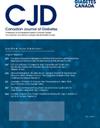Reassessing the Burden of Food Insecurity in Youth and Young Adults With Youth-onset Diabetes: The Importance of Marginal Food Security
IF 2.6
4区 医学
Q3 ENDOCRINOLOGY & METABOLISM
引用次数: 0
Abstract
Introduction
Whereas marginal food insecurity (FI) has been recognized as important in Canadian food security policy, the category of marginal food security (MFS) is often ignored in US food security research.
Methods
Prevalence of FI was estimated according to the conventional and an alternate classification of MFS with FI among 938 youth and young adults (YYA) with youth-onset type 1 diabetes (T1D) and 156 with youth-onset type 2 diabetes (T2D) from the SEARCH Food Security Cohort Study (2018–2021). Multivariable regression was used to estimate the association of MFS and conventionally defined FI ascertained with diabetes-related outcomes, including acute diabetes complications, health-care utilization, and diabetes self-management among YYA with T1D.
Results
MFS affected 10% of participants with T1D and 20% of participants with T2D. Classifying MFS with FI increased FI prevalence from 18.0% to 27.8% in participants with T1D and 34.6% to 55.1% in participants with T2D. Compared to T1D with high food security, YYA with T1D who were experiencing FI had higher odds of hypoglycemia (2.1, 95% confidence interval [CI] 1.2 to 3.6) and ketoacidosis (1.6, 95% CI 1.0 to 2.6), but no association was seen in MFS. The FI group also had higher odds of emergency department use and hospitalization (2.3, 95% CI 1.5 to 3.4; 2.4, 95% CI 1.5 to 3.9) and lower odds of technology use and checking glucose (0.6, 95% CI 0.4 to 0.9; 0.3, 95% CI 0.1 to 0.6). The MFS group exhibited associations of similar directions.
Conclusion
Health-care providers should consider care of individuals with T1D and MFS in the same way as care for those with FI.
重新评估青少年糖尿病患者的粮食不安全负担:边缘粮食安全的重要性。
导言:边缘性粮食不安全在加拿大的粮食安全政策中被认为是重要的,而在美国的粮食安全研究中,边缘性粮食不安全(MFS)类别却常常被忽视:方法:根据 SEARCH 粮食安全队列研究(2018-2021 年)中患有青年发病型 1 型糖尿病(T1D)的 938 名青年和青年成人(YYA)以及患有青年发病型 2 型糖尿病(T2D)的 156 名青年的传统和替代 MFS 粮食不安全分类,估算了 FI 的流行率。研究采用多变量回归法估算了MFS和传统定义的食物不安全(FI)与糖尿病相关结果(包括急性糖尿病并发症、医疗保健利用率和T1D青少年糖尿病自我管理)之间的关联:结果:10%的 T1D 患者和 20% 的 T2D 患者受 MFS 影响。将 MFS 与 FI 分类后,T1D 患者的 FI 患病率从 18.0% 上升至 27.8%,T2D 患者的 FI 患病率从 34.6% 上升至 55.1%。与食品安全程度高的 T1D 青少年相比,患有 T1D 的 FI 青少年发生低血糖(2.1,95%CI 1.2-3.6)和酮症酸中毒(1.6,95%CI 1.0-2.6)的几率更高,但在 MFS 中未见相关性。FI 组使用急诊室和住院的几率也较高(2.3,95%CI 1.5-3.4;2.4,95%CI 1.5-3.9),而使用技术和检查血糖的几率较低(0.6,95%CI 0.4-0.9;0.3,95%CI 0.1-0.6)。MFS组的相关性方向相似:医疗服务提供者应像护理 FI 患者一样护理 T1D 和 MFS 患者。
本文章由计算机程序翻译,如有差异,请以英文原文为准。
求助全文
约1分钟内获得全文
求助全文
来源期刊

Canadian Journal of Diabetes
ENDOCRINOLOGY & METABOLISM-
CiteScore
4.80
自引率
4.00%
发文量
130
审稿时长
54 days
期刊介绍:
The Canadian Journal of Diabetes is Canada''s only diabetes-oriented, peer-reviewed, interdisciplinary journal for diabetes health-care professionals.
Published bimonthly, the Canadian Journal of Diabetes contains original articles; reviews; case reports; shorter articles such as Perspectives in Practice, Practical Diabetes and Innovations in Diabetes Care; Diabetes Dilemmas and Letters to the Editor.
 求助内容:
求助内容: 应助结果提醒方式:
应助结果提醒方式:


